I'm new to graph theory.
I've created an adjacency graph with the QuickGraph library and ultimately, I'd like to have the connected components from the graph.
open QuickGraph
let tup = [(1M,1M); (2M, 18M); (3M, 3M); (4M, 5M); (5M, 24M); (24M, 6M); (7M, 6M); (8M, 9M); (10M, 9M)]
type Vertex = {decimal: decimal}
let edges =
tup
|> List.map (fun x -> ({decimal = fst x}, {decimal = snd x}))
|> List.map (fun x -> Edge<Vertex> x)
//Undirected Graph
let undirGraph = edges.ToUndirectedGraph()
undirGraph.Edges
undirGraph.Vertices
let x = QuickGraph.Algorithms.ConnectedComponents.ConnectedComponentsAlgorithm(undirGraph)
Output from undirGraph.Edges:
val it : Collections.Generic.IEnumerable<Edge<Vertex>> =
seq
[FSI_0227+Vertex->FSI_0227+Vertex {Source = {decimal = 1M;};
Target = {decimal = 1M;};};
FSI_0227+Vertex->FSI_0227+Vertex {Source = {decimal = 2M;};
Target = {decimal = 18M;};};
FSI_0227+Vertex->FSI_0227+Vertex {Source = {decimal = 3M;};
Target = {decimal = 3M;};};
FSI_0227+Vertex->FSI_0227+Vertex {Source = {decimal = 4M;};
Target = {decimal = 5M;};}; ...]
and from undirGraph.Vertices:
val it : Collections.Generic.IEnumerable<Vertex> =
seq
[{decimal = 1M;}; {decimal = 2M;}; {decimal = 18M;}; {decimal = 3M;}; ...]
are as expected.
The undirected graph is created successfully, but now I'm stuck. From here, I don't know how to get the connected components of the graph or, frankly, if I'm using the correct graph structure.
I would have expected x to contain the components in the graph but output from x;; in FSI looks like this:
The values in the example tuple list represent BillTo and ShipTo customer ID values in a database.
The documentation in the QuickGraph library is sparse, particularly for someone trying to "learn on the fly."
This question supplants a previous question I posted. I had considered modifying my prior question but, as this is a completely separate question, have decided to leave it as is.

